 Copyright © Michael Richmond.
This work is licensed under a Creative Commons License.
Copyright © Michael Richmond.
This work is licensed under a Creative Commons License.
The gravitationally lensed supernova in MACS J1149.6+2223
As I mentioned recently, a team of astronomers using the Hubble Space
Telescope has discovered a gravitationally lensed supernova.
I'd like to spend a bit of time today explaining
In short, a supernova is the titanic explosion which occurs when
a star blows up.
Don't Panic!
Our sun is not going to blow up -- not in the near future,
and, as far as we can tell, not ever.
Most ordinary stars like our Sun will go through some sort
of evolution over billions of years, but they remain
largely intact.
Under two different unusual circumstances, however,
a star may indeed go Kabloowie.
- A massive star runs out of fuel in its core
-
Stars which start their life with more than 7 or 8 times
the mass of our Sun will go through a series of
nuclear reactions in their core:
hydrogen fuses into helium at first,
but eventually the hydrogen runs out;
then helium fuses into carbon and oxygen,
but then the helium runs out;
then carbon and oxygen fuse into neon, etc.
In every case, the energy released by these nuclear reactions
heats the stellar interior and counters the
pull of gravity.
Finally, the star ends up with an iron core.
The trouble with iron is that when one tries to fuse
together iron nuclei, the reaction does not release energy;
instead, it sucks energy from the surroundings.
As a result, an iron core cannot heat itself up
and push back against the gravitational force.
The core collapses:
protons and electrons are crushed together to form neutrons
and a giant flood of anti-neutrinos,
which trigger a shock wave flying out away from the core.
The shock wave blasts the outer layers of the star
out into space at high speed -- KABOOM!
Astronomers call this a core collapse supernova.
You can see the remains of this type of explosion in our
own Milky Way:
the Crab Nebula is an expanding cloud of gas created
when a star exploded in the year 1054.
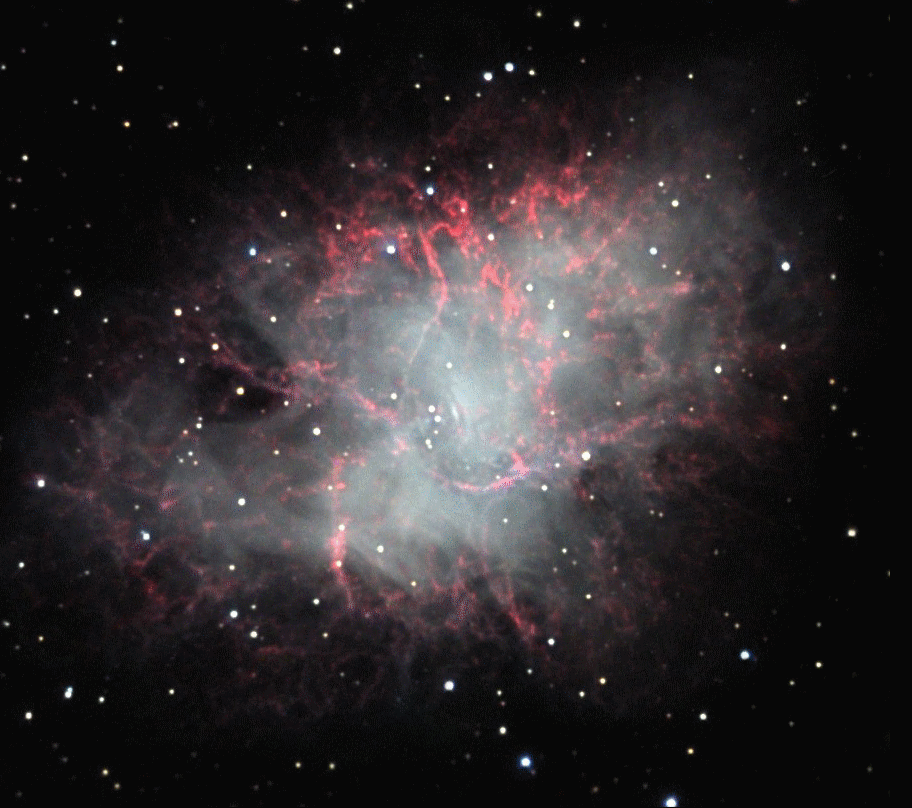
- A white dwarf grows too massive
-
Ordinary, low-mass stars like our Sun do not go through
all those stages of nuclear reaction in their cores.
They do fuse hydrogen into helium, and helium into
carbon and oxygen ... but then, they stop.
Temperatures never rise high enough to cause carbon
to fuse.
When the helium fuel runs out, the star goes through
a very mild mid-life crisis, and may gently waft its very
outermost layers into space, but basically, it remains intact.
The bulk of the star is pulled inward due to gravitational
forces, so that it shrinks and shrinks and shrinks,
from the size of the Sun to the size of the Earth.
The tiny and very dense remnant is so hot at first that it
glows with a bluish-white light -- hence the name
white dwarf. Left to itself, a white dwarf
will very slowly cool off, fade out, and turn into
a cold, solid lump.
But, if the white dwarf happens to be a member of a binary
star system, in a very tight orbit,
then it may accrete material from its companion.

Image copyright
David A. Hardy/AstroArt.org
As the white dwarf accretes material, the weight of all the
outer layers increases, squishing the center of the dwarf
harder and harder.
If enough material builds up on the surface, the center of the
dwarf can reach a hot enough, dense enough state that
thermonuclear reactions start to occur -- and then feed themselves
into a runaway reaction.
Nearly the entire white dwarf undergoes a
thermonuclear explosion,
blowing it into teeny little pieces which fly outward at
several percent of the speed of light. KABOOM!
Either way, when a star explodes,
it emits a HU-U-U-U-UGE amount of energy for a short time.
For several weeks or months,
it may grow as bright as an entire galaxy of
billions of ordinary stars.

Image courtesy of NASA
The light curve of a supernova -- the graph of its brightness
as a function of time --
has a shape which (in many cases) follows a very typical pattern.
Astronomers can use the shape and brightness of this
light curve to estimate the absolute luminosity
of the supernova and, by comparing that to its
apparent brightness, figure out its distance.

Light curve of SN 2011fe in M101 based on
measurements made at RIT and Michigan State University
The important points here are
- supernovae are VERY LUMINOUS,
so that we can see them at extremely large distances
- supernova grow much brighter and then much fainter
over the course of weeks or months
- some supernovae can be used to estimate distances accurately
A gravitational lens is just what it name implies:
a situation in which light rays are bent, not by a piece of glass,
but by the gravitational field of a massive object.
In some cases,
the background object may appear distorted and magnified
in size and brightness;
we may even see multiple images of the object!
If we do see multiple images of a single lensed object,
then, in general, the light from each image has to travel
a different distance to reach us.
That means that if the object should happen to
grow brighter (or fainter) for some reason,
each image will appear to grow brighter at a different time.
The amount of this delay depends on the exact alignment
of the observer and lens and background object,
and on the mass of the lens,
and on the distance to the lens and background object.
If we can measure a time delay between the images,
we might be able to compute the distance to the object.
Distance.
Astronomers have a difficult time measuring the distances
to celestial objects.
We can do a good job for stars in the solar neighborhood,
and make decent measurements to stars within the Milky Way Galaxy;
but as soon as we try to estimate distances
to other galaxies, we run into all sorts of problems.
Don't believe me?
Do a little reading on
"the cosmological distance ladder."
Astronomers are always looking for a new and better way
to measure distances,
especially to objects which are really, really, really
far away.
Suppose that we could find a supernova in just the right
position behind a massive object that its light was strongly bent
by the gravitational field.
That would yield
- multiple images created by a gravitational lens
- with a time delay between the images
- a source so luminous that it can be seen at
very, very large distances
- a source which varies very strongly over
just a few weeks or months,
making any time delays between images obvious
- (possibly) a source with a known luminosity,
allowing a check on the distance
This very rare circumstance would be an ideal
opportunity for astronomers to determine the distance
to a very distant object --
which in turn would provide
a check on our models
for the size and expansion rate of the universe.
Astronomers have spent years scouring the sky
for big, massive clusters of hundreds or
thousands of galaxies;
clusters so massive that their gravitational
field bends the light of objects which are
behind them.
We have created catalogs with many of these clusters,
and studied some of them in different ways.
One of these clusters is called MACS J1149.6+2223.
The name tells astronomers its location in the sky.
Here's a picture of the cluster taken
by the Hubble Space Telescope
(click on the image for a full-sized version):
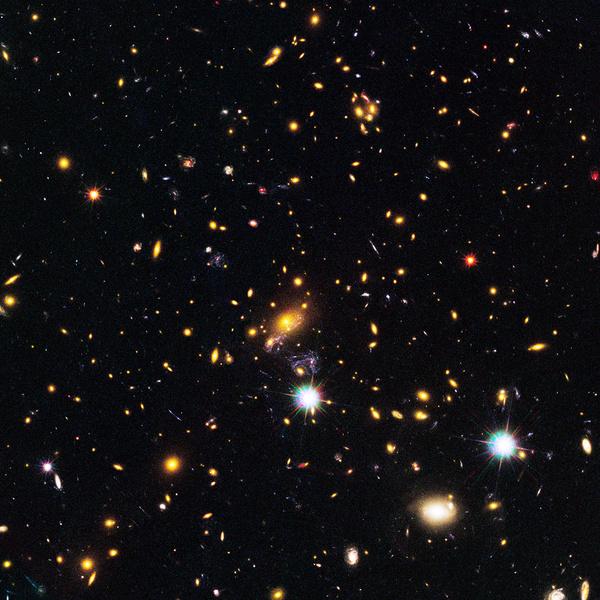
If you look closely, you'll see that there are
many short, thin "arcs" surrounding the center
of the picture. These "arcs" are background
galaxies -- the light from them has been
bent and distorted as it passes through the
cluster.
The fuzzy yellowish objects are galaxies in
the MACS cluster.
The light from these galaxies has a redshift
of z = 0.544
Q: If we observe light from this cluster
at a wavelength of 550 nm (yellow),
what was the actual wavelength of that
light when it was emitted by the galaxies?
[Hint: observed wavelength = emitted wavelength * (1 + z) ]
Q: How fast is this cluster moving away from us?
Hint:

Now, let's zoom in to look at the center of this cluster.
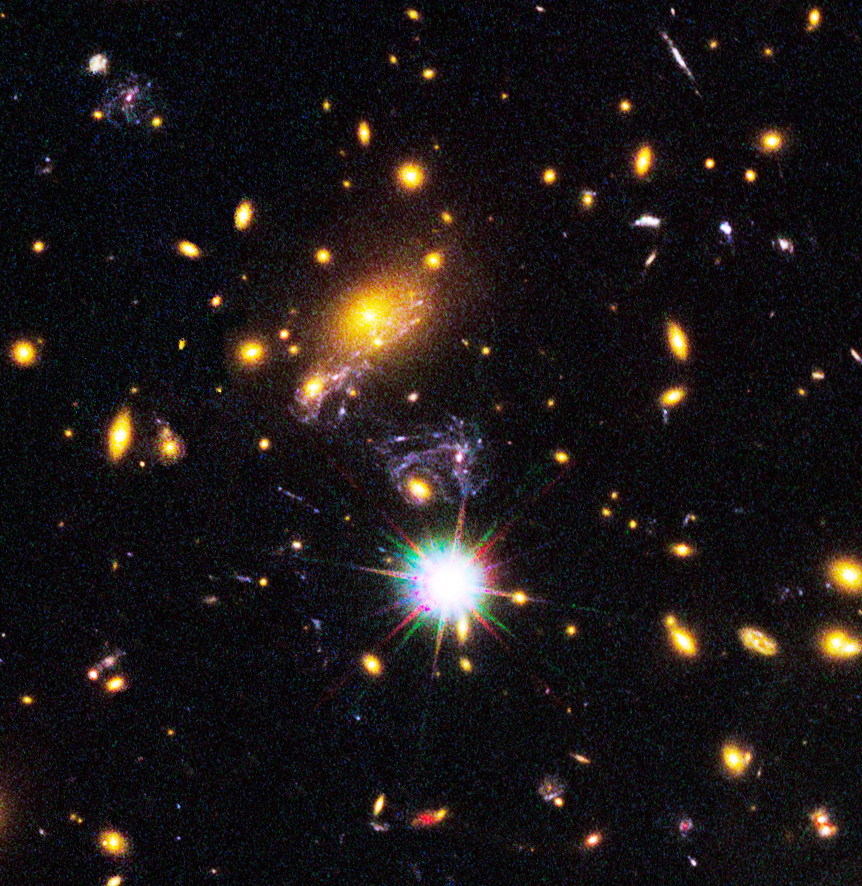
The very bright whitish object with colorful spikes
is a star in our own Milky Way Galaxy that happens
to lie in this direction.
It isn't involved in the lensing at all.
The big fuzzy yellow object is one of the
biggest, most massive galaxies in the cluster.
Between the star and the big yellow galaxy
lies a smaller yellow galaxy -- also a member
of the cluster -- and blueish spiral galaxy.
The blueish galaxy is actually not a
member of the cluster.
Instead, it is far, far behind the cluster,
much farther away from us.
The redshift of this galaxy is z = 1.491
Q: If we observe light from this spiral
galaxy at a wavelength of 400 nm (blue),
what was the actual wavelength of that
light when it was emitted by the galaxy?
[Hint: observed wavelength = emitted wavelength * (1 + z) ]
Q: How fast is this background galaxy moving
away from us?
Actually, the light from this spiral galaxy has been bent
so much by the cluster of galaxies that we can see
three different images of it near the center of the field:
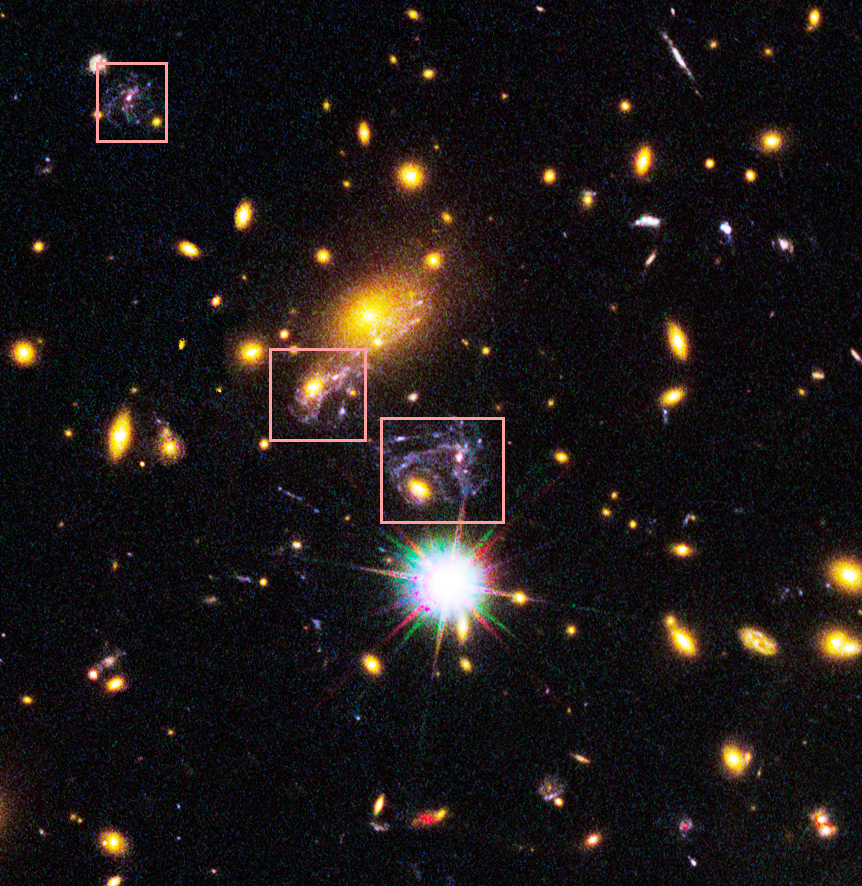
Astronomers used HST to take pictures of this
cluster of galaxies back in 2011.
In November of 2014, they took another
set of images.
A comparison of the two sets of images
revealed something NEW in the 2014 pictures.
Can you find it?
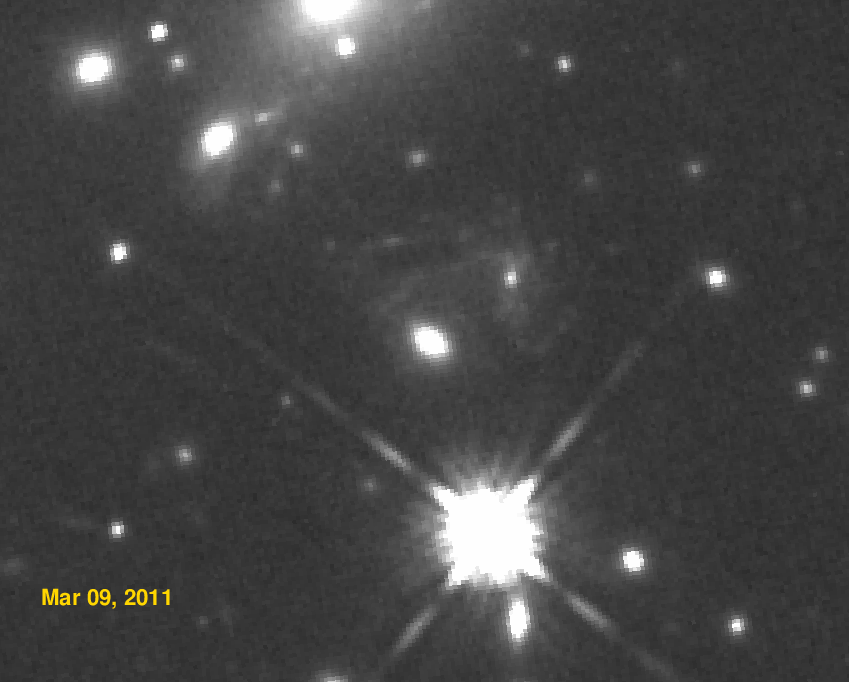
Yes -- you are seeing three bright (and one faint)
image of a (likely) supernova which has exploded
in one of the spiral arms of the background galaxy.
As soon as the supernova was noticed,
astronomers requested special time on the
Hubble Space Telescope to come back to this
part of the sky every few days
to monitor the brightness of these images.
Under ordinary circumstances, the images taken by
HST are marked as proprietary for a period of
one year after they have been taken;
only the scientists who requested the images
can access them.
That gives the scientists a chance to analyze the
images carefully and write up papers before other
scientists could scoop their results.
However, these "special time" images are not covered
by that policy.
Instead, anyone -- yes, anyone -- can download the
images from the HST archives,
as soon as they have been beamed down to the Earth
and run through the regular pipeline processing.

I've grabbed the images taken in the past few weeks
and turned them into a very low-key movie.
Can you see any changes in the little dots
of light representing the SN?

For more information
 Copyright © Michael Richmond.
This work is licensed under a Creative Commons License.
Copyright © Michael Richmond.
This work is licensed under a Creative Commons License.


 Copyright © Michael Richmond.
This work is licensed under a Creative Commons License.
Copyright © Michael Richmond.
This work is licensed under a Creative Commons License.








